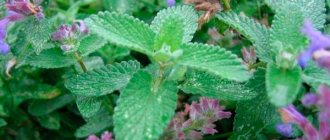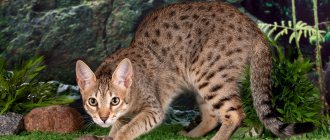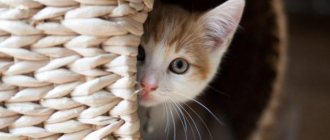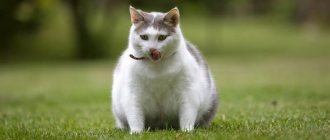Cat poisoning: signs and first aid
If your beloved cat, who until recently was affectionate, active, cheerful, but began to behave unusually, unnaturally, became lethargic, refuses food and favorite treats, this cannot but be alarming. Any changes in behavior, decreased physical activity, and the appearance of uncharacteristic clinical symptoms such as high fever, chills, vomiting, diarrhea may indicate functional disorders in the functioning of organs and systems, as well as the development of bacterial, viral, and parasitic infections.
Often, similar symptoms in animals are observed with food poisoning or severe intoxication of the body. Basic knowledge of symptoms is necessary in order to provide your beloved pet with the necessary assistance as quickly as possible before the arrival of a veterinary specialist.
Causes
Poisoning in cats is a fairly frequently diagnosed phenomenon, usually occurring at lightning speed or acutely. It should not be ruled out that this condition can also occur in a severe, protracted form. If appropriate measures are not taken, poisoning can cause serious functional disorders in the digestive tract and other organs and systems.
The main reason that can provoke poisoning in furry purrs is the hunting instinct inherent in nature, the thirst for independent research. Cats are very curious, inquisitive and very smart creatures, with well-developed hearing and sense of smell.
Cats, freely walking the streets, happily hunt for mice, birds, insects, and other attractive “prey.” In addition, furry purrs are not averse to tasting plants, new substances or game. Do not forget that rodents, pigeons, and other types of birds can be carriers of dangerous bacteria, viruses, and fungi.
In addition, it must be taken into account that infection of pets occurs not only through contact with infected individuals, but also through nutrition, by eating food contaminated with bacteria, forbidden “delicacies”, which can lead to severe food poisoning.
The main causes of poisoning in cats:
- entry into the body of potent toxic substances, poisons, chemicals;
- overdose of pharmacological drugs;
- ingestion of heavy metals (lead, aluminum);
- eating plants that are dangerous to animals;
- bites of poisonous insects, snakes;
- low-quality feed, stale food;
- severe helminthic infestations.
Poisoning in cats can be caused by poor-quality, stale, moldy food, water infected with viruses and bacteria. The cats will not refuse to try the culinary delights from our table. At the same time, you need to remember that smoked foods, sausages, spicy, salty foods, and other forbidden delicacies can provoke poisoning of your pet. Therefore, strictly remember that you need to feed cats with special professional industrial food of “premium”, “elite” class or natural food prepared especially for your beloved cat.
The greatest danger to the life and health of cats is observed when poisoning with potent chemicals - herbicides, insecticides, rat poison. For example, when hunting for a mouse, you should not rule out the fact that it is infected with dangerous viruses that release endotoxins, which contribute to the development of severe intoxication.
Cats by nature are very clean animals that constantly take care of their hygiene by licking their luxurious fur coat. At the same time, when washing your face with your paw, if there are particles of dangerous chemicals on the surface of the hairs, if they get on the mucous membranes of the oral cavity, through microcracks, wounds, abrasions, cuts on the skin, they can cause poisoning.
Poisoning in cats can be caused by tobacco smoke, household chemicals - detergents, bleaches, powders used in the household, antifreeze. Some types of indoor plants can cause severe poisoning in cats.
Dangerous indoor flora for cats:
- dieffenbachia;
- ivy;
- dracaena;
- alocasia;
- scindapsus;
- digitalis;
- philodendron;
- syngonium;
- spatephylium;
- ficus;
- exotic plant species.
Advice! Cats that do not leave their house or apartment try to clear their stomachs of hairballs and other substances by eating indoor plants that can cause harm to the body. Taking into account the physiological needs of animals, purchase special ready-made food that promotes hair removal. You can also germinate a special “grass” in containers, the seeds of which are sold in veterinary pharmacies.
The cat's body is susceptible to the effects of various acids and alkalis. Mercury, phosphates, and nitrogen-phosphorus fertilizers used for garden crops and ornamental plants are especially dangerous for cats.
We should not forget the fact that many people treat our smaller brothers inhumanely. Dog hunters appropriately add deadly baits, poisoned “treats” for animals containing strong poisons.
For example, for the intentional poisoning of cats and dogs, the drug most often used is isoniazid, a drug prescribed for the treatment of tuberculosis in humans. And this, unfortunately, is the most pressing and pressing problem of modern society.
Important! In order not to provoke the development of poisoning in a cat, when carrying out therapeutic, preventive deworming, using insecticidal and acaricidal drugs, sedatives, strictly adhere to the established dosage, which is indicated in the instructions.
Representatives of the cat family, unlike dogs, cannot be forced or taught not to pick up food from the ground, much less prohibited from hunting birds, rodents, and insects. Of course, if your pet is well-fed and happy with life, the animal will not look for food or pick up tidbits outside the home. However, no one has canceled natural instincts. A cat, kitten, cat can easily become poisoned by picking up inedible food from the surface of the ground or catching the desired prey.
Owners of furry purrs should have a good understanding of the symptoms of poisoning and know how to help the animal at home before the veterinarian arrives. In some cases, especially when cats are poisoned with strong poisons or chemicals, you need to act extremely quickly, noticing the first appearance of characteristic symptoms.
Nettle decoction for dogs
The decoction itself is no different from others - boil it and use it in a cooled state, either internally or externally. So we started cooking nettles for the dog, porridge with dried young leaves. Every day they fed them by adding a decoction to the food, or boiled the leaves along with porridge. Fortunately, we had enough dried plants - every year in the spring we collect them, dry them and store them for the winter.
While I was sick, I had to carry the dog to the toilet and for a walk. After a couple of months, Chara stood up, and six months later we forgot about the accident. The smartest, kindest dog grew up. She responded well to training and obedience. She loved to play with children and protected them from strangers, guarding the house and plot of land in the country.
Our defender was afraid of only one thing. One day, before the New Year's feast, we decided to take the dog for a walk so that we wouldn't be bothered by whining during the fun. They took him out and let him off the leash. Then they started shooting and setting off fireworks, our dog got scared and ran away. Where? No one had time to notice.
How many times they called her, shouted, whistled, and walked around everything for half a kilometer. Our dog is gone - gone. Women don’t know what to do, where else to look, children are crying. I reassured them then - they would stop blabbering and he would come back. And yes, at about four o’clock in the morning, when everything had calmed down, I looked out the window and saw our dog running at the entrance. Go, I say, meet your favorite. There was joy!
The next time they didn’t let her off the leash anymore, knowing that she was afraid of gunshots and fireworks. About six months before death, the trauma of youth made itself felt - the back part of the body began to fail. Our beloved, intelligent German Shepherd Chara lived for more than 13 years. There were other dogs in my life, but I never came across such a soulful one.
First aid
Undoubtedly, having noticed the first signs of poisoning in a pet, it is necessary to immediately take the animal to a veterinary clinic. After a comprehensive examination and diagnostic tests, the veterinary specialist will select adequate effective treatment aimed at normalizing the physiological state. For successful treatment, it is very important to determine the root cause that provoked this condition.
Still, we should not forget that poisons and chemical reagents can have different effects on the condition of animals, provoking the development of various disorders in the animal’s body. Before the veterinarian arrives, you can help your cat in case of poisoning yourself.
If you are sure that the cause of poisoning is caused by low-quality, stale food, to normalize the general condition you need to give your pet emetics (Apomorphine, Detox) in order to neutralize the effect of toxins and poisons as quickly as possible.
To neutralize the effect of toxins, the cat needs to pour a weakly concentrated solution of potassium permanganate, baking soda, table salt into the oral cavity through a syringe without a needle in a ratio of 1:4 (one part salt/soda per liter of water) to provoke vomiting.
In case of food poisoning, infusion of hydrogen peroxide in equal proportions with water will help eliminate the symptoms of intoxication. This solution should be poured slowly, every 15-20 minutes, 150-200 ml orally. Dosage – 20 g (teaspoon) per 1 kg of animal weight.
To provoke vomiting, warm boiled water and a decoction of medicinal chamomile are injected into cats with a disposable syringe every 10-15 minutes to cleanse the stomach. The main thing is to provoke the gag reflex (vomiting) as quickly as possible to prevent symptoms of intoxication and dehydration.
If you have experience, warm enemas based on decoctions of medicinal plants (chamomile, St. John's wort, yarrow, plantain) will help alleviate the suffering of your pet.
After cleansing the body of toxins that caused food poisoning, cats are given absorbents crushed into powder - White, activated carbon at the rate of one tablet per 5 kg of animal body weight, Enterosgel, Atoxil.
Intravenous infusions - intravenous administration of glucose, Ringer's solution (saline solutions) will help normalize the general condition and water-salt metabolism in the pet's body. Such measures will have the desired effect if the medical manipulations are carried out by a veterinarian.
Advice! When animals are poisoned, a good result is achieved by the introduction of mucous enveloping solutions that cover the gastric mucosa, preventing the absorption of poisons. The cat can be infused with a solution of flax seed, tannin, rice water, and egg white every two to three hours, if there are no contraindications).
The action of heavy metals will help neutralize the raw egg white, after which the animal is given a warm saline solution or a large amount of boiling warm water to induce vomiting.
If the cat's poisoning is caused by household chemicals that have got on the fur, before treatment you need to wash the fur with laundry soap or animal shampoo. To provoke vomiting, place 8-10 g of table salt on the root of the tongue. After vomiting, the cat is given sorbents and infused with decoctions of medicinal herbs.
Even if the cat was poisoned in a timely manner at home, if the condition is completely stabilized, be sure to consult a veterinarian and take the animal to a veterinary hospital. The veterinarian will select symptomatic therapy for your pet, depending on the root cause and symptoms.
To make an accurate diagnosis, it is recommended to take samples of vomit and feces into sterile containers, which can be purchased at a veterinary pharmacy or clinic. Still, it should not be ruled out that vomiting and other symptoms may indicate the development of an infection in the body. In this case, when making a more accurate diagnosis, differential diagnosis will be carried out.
When visiting a veterinary hospital, four-toed patients will be prescribed a therapeutic diet, special professional ready-made food, probiotics, enzyme preparations, and diuretics. Hepatoprotectors will help reduce the toxic effect on the liver and normalize the functions of the organ.
If cats are poisoned by medications, household chemicals, or chemical components, it is necessary to immediately perform a gastric lavage and call a veterinarian at home. Animals at the veterinary clinic undergo gastric lavage and are given maintenance drips, which will help neutralize the effects of toxins as quickly as possible and restore the animals’ general condition.
How to treat a pet
Treatment of cystitis in cats at home is possible only after all the necessary diagnostic tests have been carried out and drug therapy has been prescribed.
The course of treatment includes:
- symptomatic therapy (antispasmodics, analgesics);
- antimicrobial drugs and herbal uroseptics;
- medicines for the correction and treatment of the underlying pathology;
- diet and proper drinking regimen.
Before contacting a veterinarian, no medications should be given to a sick pet. If the pain is severe, you can administer a dose of antispasmodic to the cat, calculated according to the weight of the animal. You should inform your doctor about this at your appointment.
Injections for a cat
The preferred form of administration of painkillers and antimicrobial drugs is injections. Parenteral administration ensures the required concentration of active substances in the body, a quick effect and the absence of complications from the gastrointestinal tract.
The following medications are administered to cats in the form of injections:
- antispasmodics (No-shpa, Papaverine);
- analgesics (Baralgin, Analgin, Revalgin);
- antibiotics (Gentamicin, Amoxiclav, Levomycetin);
- immunostimulants (IBS).
Antimicrobial agents should be given in a course, without stopping therapy at the first signs of relief in the cat’s condition.
The following medications may be prescribed for oral administration:
- Salol;
- CatErwin;
- Stop cystitis;
- Canephron;
- Cyston;
- Cantaren;
- probiotics (Lactovit, Bifitrilak).
Traditional methods of treatment
Treating a cat without the advice of a veterinarian is very dangerous, because... this can lead to chronicity of the disease and the development of complications in the kidneys.
Step-by-step treatment plan.
With the permission of the doctor, symptomatic therapy can be supplemented with infusions and decoctions of the following plants:
- plantain, bearberry, birch, lingonberry, nettle (leaves);
- cinquefoil;
- horsetail;
- chamomile (flowers), etc.
CatErwin or Stop-cystitis: which is better?
KotErwin are anti-inflammatory and mild diuretic drops that contain extracts of knotweed (field and kidney), horsetail and steelhead root. This drug is best suited for the prevention of urolithiasis and urological syndrome.
Stop-cystitis contains both herbal components (extracts of juniper, lingonberry and birch leaves, nettle, knotweed and licorice root) and medicinal preparations (antibiotic nitroxoline and antispasmodic drotaverine). It comes in tablet form and is suitable for the treatment of bladder inflammation.
Stop Cystitis Bio contains only herbal ingredients and is suitable for the prevention of cystitis in cats.
Chamomile decoction for cat poisoning at home
If an animal develops symptoms of poisoning, you should immediately call a veterinarian, and while it is traveling, first aid must be provided. No matter what toxic poison a cat is poisoned with, it is first necessary to remove it from the body, this must be done very quickly before the poison can be absorbed into the pet’s body. Therefore, in case of poisoning, the cat must be given one of the following drugs:
- Activated carbon - used for intestinal toxic infections and poisoning with salts of heavy metals. Half a tablet two to three times a day. Not recommended for use in kittens under six months of age.
- Enetrosgel - used to remove mineral and organic poisons from the body, can be used at any age. Noram for a cat weighing 4 kg - 2 times a day, half a teaspoon.
- Smecta not only removes the toxic effects of poisons, but also prevents the effects of hydrochloric acid and bile salts. Dose: 0.5 sachets, diluted in 50 ml of water, given to an adult cat at one time, to a kitten 2-3 times.
- A solution of potassium permanganate is usually used when the etiology of poisoning is unknown. Potassium permanganate is diluted to obtain a solution of bright crimson color and 4-5 tablespoons are poured into the cat’s mouth at a time.
It is important to remember that giving an activated carbon tablet to a cat in case of poisoning does not mean curing it of the disease; the sorbent can remove the toxin from the body, and the animal needs further therapy and rehabilitation.
It is necessary to ensure that the poisoned animal drinks as much water as possible, as toxic substances can harm the liver and kidneys. If the animal refuses to drink, it is necessary to administer liquid using a syringe without a needle - at least 300 ml per day.
In addition to ordinary water, you can give your cat a chamomile decoction or sweet black tea.
In case of poisoning with certain poisons - fluoride compounds or chloride bleach, milk can be used as an astringent that removes the poison from the body. It is capable of removing fluorine and chlorine from a cat’s body and neutralizing a number of other toxic substances. The animal must drink at least 15 mg per 1 kg of the pet’s weight, a larger amount is also acceptable.
Chamomile
There is chamomile (German) and Roman chamomile. They differ in the number of petals and sizes. Chamomile is an annual plant with several flowers and stems. Roman chamomile is a creeping perennial with a wider flower pattern. In medicine, chamomile is mainly used, as it is believed to have a more powerful therapeutic effect.
The healing properties of chamomile are well known. Decoctions and tinctures can be used to treat any chronic or acute disorders of the digestive system, allergies, flea bites, various bacterial or fungal infections. Chamomile is used against seizures and as a sedative. It is less toxic than anthelmintics such as wormwood, black walnut and garlic, although it does not act as quickly. The advantage of chamomile is that it neutralizes the harmful effects of parasites on the intestinal mucosa.
Use chamomile tincture mixed with glycerin at the rate of 0.25-0.50 ml per 8 kg of animal body weight. This medicine is best taken in the mouth as it helps against gingivitis. You can add thyme, echinacea and apply the mixture to the animal’s gums with a cotton swab.
A cooled chamomile decoction is diluted with saline and used to wash the eyes of cats and dogs.
For rinsing after swimming and fighting intestinal parasites, it is better to take fresh flowers, but dried chamomile has a more pleasant taste. To enhance the effects of chamomile, mix it with fennel, plantain, white oak bark and wormwood (4 parts chamomile and 1 part other herb).
Chamomile should not be given to pregnant cats and dogs, as it can cause miscarriage or slow down the normal growth of the fetus.
What is strictly forbidden to do in case of poisoning
On some veterinary forums there is an opinion that poisoning in a cat can be dealt with with the help of vodka. It's a delusion. It is strictly forbidden to give a cat vodka for poisoning. The lethal dose of alcohol for a cat is 4-5 ml per 1 kg of weight; if you consider that a tablespoon contains 15 ml of vodka, the animal may even die from such treatment. When vodka enters the body, all blood vessels dilate, which means the poison disperses much faster, even after the animal is taken to the clinic, treatment may not help, since the vessels will already be narrowed and the drugs will enter the body much slower than alcohol and poisons got there.
Also, in case of poisoning, without the advice of a doctor, you should not induce vomiting in the animal, as this can lead to suffocation. Feeding the animal on the first day is also prohibited.
After providing first aid, the pet must be taken to a veterinarian, who will treat it based on how the poison entered the animal’s body and the general condition of the cat.
Valerian
There are countless stories about cats' love for valerian. This plant has a calming effect on people, but on cats, on the contrary, it is extremely stimulating. Therefore, it should be used with great care. If you grow valerian at home, your cat should not have easy access to it.
The plant is useful for animals suffering from gastrointestinal diseases, impaired digestion, it quickly normalizes the functioning of the thyroid gland, and helps with heart failure.
Despite the numerous beneficial properties of valerian for the cat's body, veterinarians do not often prescribe it for the treatment of pets. The fact is that cats quickly get used to the drug, and the owners indulge their pet’s whims in every possible way. Over time, valerian becomes a drug for cats. If you leave a bottle of medicine in the cat's reach, it will manage to drink valerian, and an overdose can be fatal.
The excavator independently loads onto the platform using a bucket: video
Australia is creating Covid testing sites in shipping containers
The charming youngest son of Vladimir Tolokonnikov followed in his footsteps: photo
Factors causing diarrhea in cats
Diarrhea can be caused by a number of illnesses.
The common cause of the appearance is considered to be disturbances in the digestive tract caused by a number of diseases:
- helminthic infestation;
- viral infection;
- fungal infection;
- diabetes;
- intestinal obstruction;
- kidney disease;
- liver disease;
- tumors.
Additional factors include: stress, spoiled food, individual intolerance to a particular product.
Symptoms of diarrhea
A preliminary diagnosis of the problem can be made based on the nature of stool, frequency, color, and the presence of impurities.
Normally, cat feces have a fixed shape and soft consistency. The color depends on what the pet ate. Typically varies from dark yellow to brown.
Feces are yellow in color due to poor digestion of food. Rich yellow or orange is a sign of increased bilirubin and liver problems.
Treatment at home
When starting to treat an animal, it is necessary to find out the composition of its latest menu. The presence of raw fish, liver, fatty meat, and sour milk in it was more likely to provoke the disorder. After removing these foods from the diet, you should monitor your pet’s next bowel movement.
If the diarrhea stopped, this was the reason, and the disorder was an isolated case. The stomach may react to a change in water. In this case, you should return to the cat’s usual drink.
First aid
The first pre-medical aid will be a starvation diet for about a day, and there must certainly be free access to water, since the body becomes dehydrated during a disorder.
Activated carbon would be a good solution. It should be given at the rate of one tablet per 10 kg of body weight, dissolving it in boiled water.
Chamomile decoction
Chamomile decoction can be purchased at the pharmacy, or you can make it yourself. More on this below.
A decoction of chamomile is recommended. The plant has antispasmodic, anti-inflammatory, disinfectant properties, helps with bloating, diarrhea, and abdominal pain. To do this, take one tablespoon of the crushed plant and pour a glass of water. Boil, strain. Give your cat one tablespoon twice a day. For a kitten – one teaspoon.
St. John's wort herb
St. John's wort herb has a good hemostatic effect.
The herb St. John's wort has astringent and healing properties.
Yarrow has antispasmodic and hemostatic effects. It has a beneficial effect on intestinal smooth muscles, the gallbladder and its ducts. A collection of yarrow and St. John's wort is taken in equal parts, in the amount of one tablespoon, poured with a glass of water, boiled, cooled, filtered. Give the animal one tablespoon twice a day. For kids - one teaspoon.
Yarrow herbal mixture
Herbal mixture of yarrow - 5 parts, plantain leaves - 3 parts. Chamomile, color - 2 parts, St. John's wort - 2 parts, cinquefoil - 2, rose hips - 2, green shoots of horsetail - 1 part. Prepare an infusion: pour a tablespoon of the crushed extract into 200 ml of boiled water. Leave for an hour. Give to the animal four times a day half an hour before meals. Doses: therapeutic – 10 ml, prophylactic – 5 ml. It is recommended to give a therapeutic enema from this collection.
Medicinal fees
Medicinal collection: cinquefoil - 3 parts, lingonberry leaves - 2, rose hips - 2 parts, tansy flowers - 1 part, yarrow herb - 1, chamomile - 1. Prepare an infusion at the rate of: 1 tablespoon of crushed collection per 1 a glass of boiling water. Therapeutic dose is 6 ml, prophylactic dose is 4 ml. A therapeutic microenema is recommended.
Herbal collection Brusniver from lingonberries and rose hips.
Recommendations for the use of medicinal preparations, as well as drug therapy, are provided by a veterinarian.
It is strictly not recommended to make decisions on the use of certain medications on your own. Medicines prescribed by the doctor are aimed at eliminating the causes of diarrhea.
What to do if there are white grains in the stool?
Main article: White specks in cat stool.
Infection with helminthic infestation is recommended to be treated with the following drugs: febtal, polyvercan, dirofen, profender, troncil, pyrantel, canikquantel, prazitel. Additionally, anti-inflammatory and antispasmodics are prescribed.
Viral infection
In cases of severe intestinal infection and severe diarrhea, your veterinarian may recommend using a diaper.
A viral infection is eliminated based on the type and type of virus that has infected the animal’s intestines. The general purpose will be antiviral drugs, anti-inflammatory drugs, antispasmodics, probiotics.
Intestinal obstruction is eliminated with droppers, painkillers, anti-inflammatory drugs, and antibiotics. In severe cases, urgent surgical intervention is indicated.
Prevention of diarrhea
To avoid recurrence of diarrhea and to prevent infection, it is necessary to strictly adhere to the principles of prevention.
You should carefully monitor your pet. Control your diet and do not overfeed. It is unacceptable to feed the animal raw foods. Fish and meat must be subjected to heat treatment. The products consumed must be fresh and of the highest quality.
Do not overfeed the animal!
Do not buy dry food of an unknown brand.
It is important to undergo timely medical examination for preventive purposes. Do not forget about periodic treatment of the room, the pet’s habitat, and its dishes for worms and parasites. Comply with sanitary and hygienic standards. For preventive purposes, regularly give your pet medications against helminthic infestation.
Carefully monitor what product your cat reacts to atypically. Be sure to exclude it from your diet. Always change the water at least 1-2 times a day. Drinks should be fresh, clean, filtered. Timely vaccination of the animal, according to the schedule developed by the treating veterinarian.
Do not resort to treatment on your own - only after consulting with a specialist.
Burdock
Burdock root is used as a diuretic and choleretic agent. In addition, it is an excellent source of minerals and vitamins. 100 g of fresh burdock root contains 61 mg of calcium, 77 mg of phosphorus, 1.4 mg of iron, 0.03 mg of thiamine and 0.05 mg of riboflavin.
Since ancient times, burdock has been used to treat the liver, as a result of which the skin is often restored, since skin diseases are closely related to the accumulation of toxins. Burdock will cleanse your pet's body of pesticides and other pollutants, renew the blood, remove excess bile, and help produce enzymes needed to absorb nutrients. Burdock is used to treat arthritis, urolithiasis and bladder infections. This is an excellent remedy for animals that have suffered from poor nutrition.
Most animals do not like burdock, so it is very difficult to give a dog or cat a decoction to drink. Use only tincture. It is more concentrated and has a sweetish taste.
Burdock roots are dug up in the fall after the leaves die. In the second year, you can use only those roots that are collected in early spring.
To treat skin diseases, burdock can be combined with licorice, red clover and dandelion, and to treat the liver, mixed with milk thistle. To strengthen the immune system, use a mixture of burdock with echinacea or astragalus.











